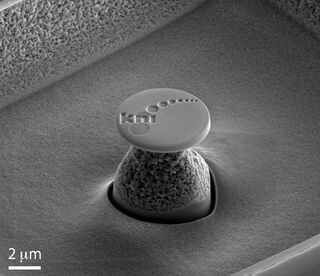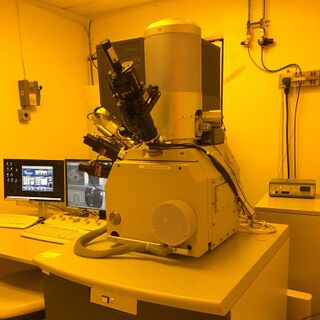Nova 600 NanoLab: SEM, Ga-FIB, GIS & Omniprobe: Difference between revisions
Jump to navigation
Jump to search
mNo edit summary |
No edit summary |
||
| Line 25: | Line 25: | ||
* Platinum deposition via Gas Injection System (GIS) | * Platinum deposition via Gas Injection System (GIS) | ||
* Automated imaging with RunScript program & AutoScript language | * Automated imaging with RunScript program & AutoScript language | ||
===== Ga-FIB Applications ===== | ===== Ga-FIB Applications ===== | ||
* Directly etch patterns into material | * Directly etch patterns into material | ||
| Line 72: | Line 71: | ||
* [http://www.srim.org/ The Stopping & Range of Ions in Matter (SRIM) – simulate i-beam/specimen interactions] | * [http://www.srim.org/ The Stopping & Range of Ions in Matter (SRIM) – simulate i-beam/specimen interactions] | ||
===== Calibrate Measurements with NIST Standard ===== | ===== Calibrate Measurements with NIST Standard ===== | ||
* The KNI has a NIST-traceable standard against which SEM and Ga-FIB measurements can be compared. See [https://caltech.box.com/s/lulkj0pwm053akyya1shazg8wzgudq9f | * The KNI has a NIST-traceable standard against which SEM and Ga-FIB measurements can be compared. See Slides 54-55 of the [https://caltech.box.com/s/lulkj0pwm053akyya1shazg8wzgudq9f SEM Presentation] for details. Ask staff for help finding and using the standard in the lab. | ||
===== Order Your Own Stubs ===== | ===== Order Your Own Stubs ===== | ||
* Stubs used for mounting specimens are considered a personal, consumable item in the KNI. There are some old stubs at each SEM, yet you should buy your own so that you can keep them clean and available to you. There are many stub geometries and configurations, some of which will be right for you to purchase and keep with your other cleanroom items. | * Stubs used for mounting specimens are considered a personal, consumable item in the KNI. There are some old stubs at each SEM/FIB, yet you should buy your own so that you can keep them clean and available to you. There are many stub geometries and configurations, some of which will be right for you to purchase and keep with your other cleanroom items. | ||
** [https://www.tedpella.com/SEM_html/SEMclip.htm.aspx Buy stubs with copper clips (recommended for most devices, esp with non-conductive substrates) | ** [https://www.tedpella.com/SEM_html/SEMclip.htm.aspx Buy stubs with copper clips] (recommended for most devices, esp with non-conductive substrates); | ||
** [https://www.tedpella.com/sem_html/SEMpinmount.htm Buy stubs without copper clips (ok for devices with conductive substrates) | ** [https://www.tedpella.com/sem_html/SEMpinmount.htm Buy stubs without copper clips] (ok for devices with conductive substrates) | ||
== Specifications == | == Specifications == | ||
| Line 91: | Line 90: | ||
* TLD Bias Range: -100 to 150 V | * TLD Bias Range: -100 to 150 V | ||
* Ultimate Vacuum: 5e-7 mbar | * Ultimate Vacuum: 5e-7 mbar | ||
===== Ga-FIB Specifications ===== | ===== Ga-FIB Specifications ===== | ||
* Minumum Probe Size Achieved: ~7 nm | * Minumum Probe Size Achieved: ~7 nm | ||
Revision as of 20:38, 6 May 2019
|
Description
The Nova 600 is a "dual beam" system that combines a field emission gun (FEG) scanning electron microscope (SEM) with a gallium focused ion beam (Ga-FIB). It can be used to capture high quality images (with sub-10 nm resolution) and perform site-specific etching and material deposition (with sub-50 nm resolution). It is also equipped with an Omniprobe nanomanipulator, which can be used to lift out lamella samples prepared for use in a transmission electron microscope (TEM). See a full list of training and educational resources for this instrument below.
SEM Applications
- Ultra-High-Resolution Imaging (Immersion Mode aka UHR Mode)
- High-Resolution Imaging (Field-Free Mode aka Normal Mode)
- Secondary Electron (SE) imaging with an Everhart-Thornley Detector (ETD) & Through-the-Lens Detector (TLD)
- Backscattered Electron (BSE) imaging with a TLD
- Platinum deposition via Gas Injection System (GIS)
- Automated imaging with RunScript program & AutoScript language
Ga-FIB Applications
- Directly etch patterns into material
- Cutting & Imaging Cross-Sections
- TEM Lamella Sample Preparation using an Omniprobe for Liftout
- Platinum & SiOx deposition via GIS
- Enhanced etch with XeF2 via GIS
- Automated patterning with RunScript program & AutoScript language
Resources
SOPs & Troubleshooting
- SEM SOPs (Short Version | Long Version)
- Ga-FIB SOPs (Short Version | Long Version)
- TEM Lamella Sample Preparation SOPs (Short Version | Long Version)
- Cutting & Imaging Cross-Sections SOP
- Troubleshooting Guide
Video Tutorials
- Getting Started | Basic SEM Alignment
- Astigmatism Correction (Details | On Right-Angle Features | Stigmator Alignment)
- Eucentric Height: What it means, When to use it & How to get there
- TEM Lamella Sample Prep (Playlist)
- Cutting & Imaging Cross-sections (Playlist)
- Milling Non-Conductive Samples using Charge Compensation
- Perfecting Ga-FIB Alignments
- Adjusting TLD Voltage to Capture SE vs. BSE Signal
Graphical Handouts
Presentations
- Scanning Electron Microscopy: Principles, Techniques & Applications
- Gallium Focused Ion Beam Microscopy: Principles, Techniques & Applications
Manufacturer Manuals
- Nova NanoLab Operation Manual
- EDAX Genesis EDS & WDS Operation Manual
- Gas Injection Systems – Deposition of Platinum (Technical Note)
- Gas Injection Systems – Deposition of SiOx (Technical Note)
- Gas Injection Systems – Etching with IEE aka XeF2 Etch (Technical Note)
- Gas Injection Systems – Beam Chemistries Presentation
- Scripting – AutoScript Language Manual (year 2000 Technical Note: most complete)
- Scripting – AutoScript Language Manual (year 2005 Technical Note: less complete, still useful)
- Scripting – RunScript Manual
Simulation Software
- CASINO Electron Beam Simulation Software – simulate e-beam/specimen interactions
- The Stopping & Range of Ions in Matter (SRIM) – simulate i-beam/specimen interactions
Calibrate Measurements with NIST Standard
- The KNI has a NIST-traceable standard against which SEM and Ga-FIB measurements can be compared. See Slides 54-55 of the SEM Presentation for details. Ask staff for help finding and using the standard in the lab.
Order Your Own Stubs
- Stubs used for mounting specimens are considered a personal, consumable item in the KNI. There are some old stubs at each SEM/FIB, yet you should buy your own so that you can keep them clean and available to you. There are many stub geometries and configurations, some of which will be right for you to purchase and keep with your other cleanroom items.
- Buy stubs with copper clips (recommended for most devices, esp with non-conductive substrates);
- Buy stubs without copper clips (ok for devices with conductive substrates)
Specifications
Manufacturer Specifications
- Nova 600 NanoLab Data Sheet (not all parameters apply to our instrument, see below for details specific to the KNI's Nova 600)
SEM Specifications
- Minimum Feature Size Resolved in Immersion Mode: ~5 nm
- Voltage Range: 0.2 to 30.0 kV
- Current Range: ~10 pA to 20 nA
- Apertures: 10 μm, 15 μm, 20 μm, 30 μm
- Eucentric Height: ~5.15 mm working distance (WD)
- Stage Range: +/- 80 mm X & Y travel, 12 mm Z travel, -12 to 58° tilt, 360° rotation
- ETD Grid Bias Range: -150 to 300 V
- TLD Bias Range: -100 to 150 V
- Ultimate Vacuum: 5e-7 mbar
Ga-FIB Specifications
- Minumum Probe Size Achieved: ~7 nm
- Minimum Feature Size Etched: ~25 nm
- Minimum Feature Size Resolved by Imaging: ~10 nm
- Voltage Range: 5 to 30 kV
- Current Range: 1 pA to 20 nA
- Eucentric Height: ~5.15 mm working distance (WD)
- Stage Tilt to be perpendicular to Ga-FIB: 52°
- ETD Grid Bias Range: -150 to 300 V
- TLD Bias Range: -100 to 150 V

